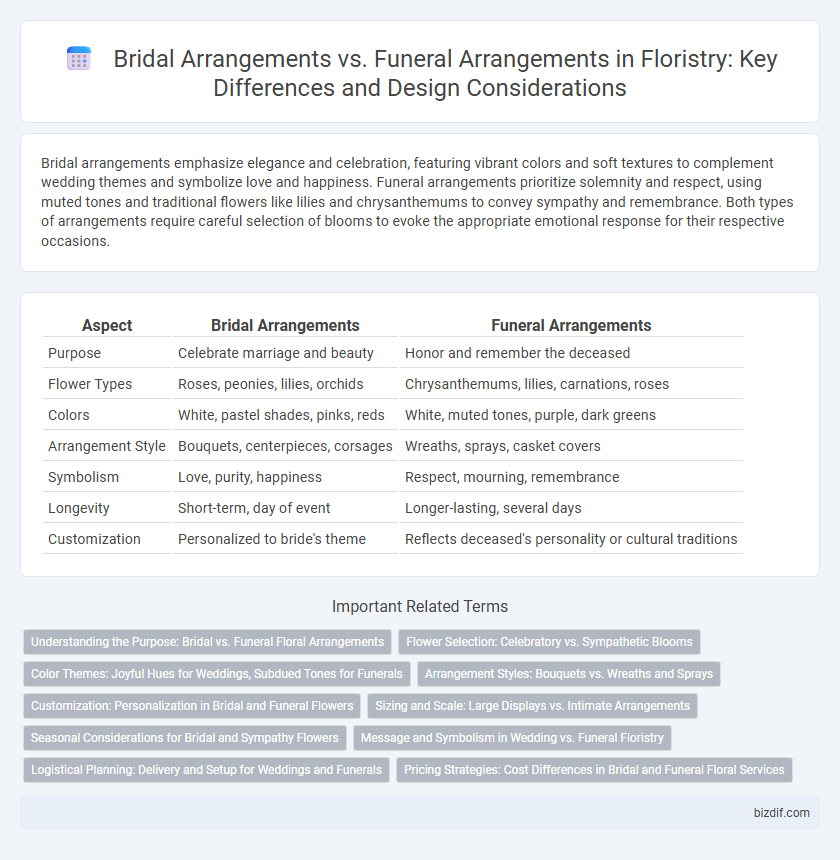Bridal arrangements emphasize elegance and celebration, featuring vibrant colors and soft textures to complement wedding themes and symbolize love and happiness. Funeral arrangements prioritize solemnity and respect, using muted tones and traditional flowers like lilies and chrysanthemums to convey sympathy and remembrance. Both types of arrangements require careful selection of blooms to evoke the appropriate emotional response for their respective occasions.
Table of Comparison
| Aspect | Bridal Arrangements | Funeral Arrangements |
|---|---|---|
| Purpose | Celebrate marriage and beauty | Honor and remember the deceased |
| Flower Types | Roses, peonies, lilies, orchids | Chrysanthemums, lilies, carnations, roses |
| Colors | White, pastel shades, pinks, reds | White, muted tones, purple, dark greens |
| Arrangement Style | Bouquets, centerpieces, corsages | Wreaths, sprays, casket covers |
| Symbolism | Love, purity, happiness | Respect, mourning, remembrance |
| Longevity | Short-term, day of event | Longer-lasting, several days |
| Customization | Personalized to bride's theme | Reflects deceased's personality or cultural traditions |
Understanding the Purpose: Bridal vs. Funeral Floral Arrangements
Bridal floral arrangements symbolize celebration, love, and new beginnings, often featuring vibrant blooms like roses, peonies, and lilies to complement wedding themes and color palettes. Funeral floral arrangements convey sympathy, respect, and remembrance, typically incorporating muted tones and traditional flowers such as chrysanthemums, lilies, and carnations to express condolences. Understanding these distinct purposes guides florists in selecting appropriate designs, colors, and flower types to honor the occasion effectively.
Flower Selection: Celebratory vs. Sympathetic Blooms
Bridal arrangements typically feature vibrant, celebratory blooms such as roses, peonies, and lilies, chosen for their symbolism of love, new beginnings, and joy. Funeral arrangements prioritize sympathetic flowers like chrysanthemums, carnations, and lilies, which convey respect, remembrance, and mourning. The choice of blooms reflects the occasion's emotional tone, with bright, uplifting colors for weddings and subdued, calming hues for funerals.
Color Themes: Joyful Hues for Weddings, Subdued Tones for Funerals
Bridal arrangements often feature vibrant colors such as blush pinks, ivory whites, and soft pastels that evoke joy and celebration, enhancing the romantic atmosphere of weddings. In contrast, funeral arrangements typically utilize subdued tones like deep purples, muted greens, and gentle whites to convey respect, solemnity, and remembrance. The choice of color themes plays a crucial role in setting the emotional tone for both weddings and funerals, reflecting the distinct nature of each occasion.
Arrangement Styles: Bouquets vs. Wreaths and Sprays
Bridal arrangements typically feature elegant bouquets designed for personal holding and aesthetic appeal, emphasizing delicate blooms like roses, peonies, and lilies arranged in compact, handheld styles. Funeral arrangements primarily involve wreaths and sprays meant for display at memorials or gravesites, often incorporating evergreen foliage, lilies, chrysanthemums, and carnations to symbolize mourning and remembrance. The contrasting styles reflect their purpose, with bridal bouquets focusing on beauty and celebration, while funeral wreaths and sprays convey respect and solemnity.
Customization: Personalization in Bridal and Funeral Flowers
Bridal arrangements emphasize personalized designs that reflect the couple's style, incorporating specific flower types, colors, and themes to enhance the wedding's atmosphere. Funeral arrangements focus on customization to honor the deceased, often including symbolic flowers and messages tailored to the individual's life and family preferences. Both types of floral arrangements prioritize meaningful personalization to convey deep emotions and create lasting impressions.
Sizing and Scale: Large Displays vs. Intimate Arrangements
Bridal arrangements often feature intimate, carefully scaled bouquets designed to complement the bride and bridal party, focusing on elegance and personal touch. Funeral arrangements typically involve large displays such as standing sprays and wreaths, intended to create a significant visual impact and convey respect on behalf of the community or family. The size difference reflects the purpose; bridal flowers emphasize personal connection, while funeral arrangements prioritize visibility and solemnity.
Seasonal Considerations for Bridal and Sympathy Flowers
Bridal arrangements often highlight seasonal blooms like peonies in spring and dahlias in autumn, enhancing wedding themes with fresh, vibrant colors and textures. Funeral arrangements prioritize flowers such as lilies and chrysanthemums that are traditionally available year-round, ensuring respectful and enduring expressions of sympathy regardless of season. Understanding seasonal availability helps florists provide optimal floral selections that align with the distinct emotional tones of weddings and memorials.
Message and Symbolism in Wedding vs. Funeral Floristry
Bridal floral arrangements symbolize love, joy, and new beginnings, often incorporating flowers like roses, peonies, and lilies that convey romance and celebration. Funeral arrangements emphasize remembrance, respect, and mourning, using flowers such as chrysanthemums, lilies, and carnations to express condolences and honor the departed. The message in wedding floristry highlights hope and unity, while funeral floristry focuses on reverence and solace.
Logistical Planning: Delivery and Setup for Weddings and Funerals
Bridal arrangements require precise timing and delicate handling to ensure fresh, flawless flowers are delivered and set up at the ceremony and reception venues, often involving coordination with wedding planners and florists for installations like arches or centerpieces. Funeral arrangements demand respectful and timely delivery directly to the funeral home or cemetery, with careful placement of wreaths, sprays, or casket flowers that honor the deceased while accommodating potentially strict venue guidelines. Efficient logistical planning for both occasions includes load management, temperature control during transit, and contingency plans for weather or traffic delays to maintain the quality and impact of the floral displays.
Pricing Strategies: Cost Differences in Bridal and Funeral Floral Services
Bridal arrangements typically command higher prices due to the intricate designs, premium flowers, and personalized consultations involved in creating unique bouquets and centerpieces for weddings. Funeral arrangements, while often simpler and more standardized, focus on respectful expression and may utilize cost-effective blooms to accommodate families' budgets during difficult times. Pricing strategies in floristry account for the event's emotional significance, complexity, and seasonal availability, leading to distinct cost structures for bridal versus funeral floral services.
Bridal arrangements vs Funeral arrangements Infographic

 bizdif.com
bizdif.com